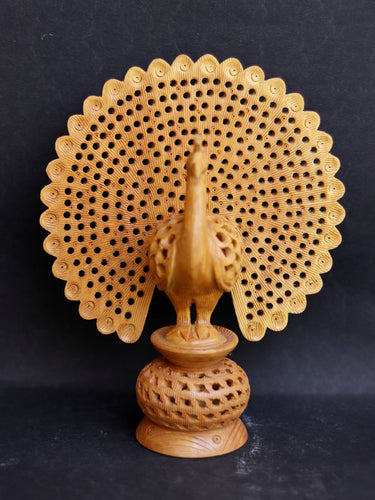
Sandalwood & Kadam Wood Carving
ODOP

ODOP
Sandalwood and Kadam wood carving are revered forms of traditional Indian craftsmanship that exemplify the country’s rich artistic heritage. These carvings are celebrated for their intricate designs, exquisite detailing, and the spiritual and cultural narratives they often embody. Sandalwood, known for its distinctive fragrance and fine texture, has been a favored medium for centuries, while Kadam wood, known for its workability and durability, is similarly valued for its versatility in carving. Together, these woods form the basis for an array of artistic expressions, ranging from religious icons and mythological scenes to decorative items and everyday objects, reflecting the deep-seated connection between art, nature, and spirituality in Indian culture.
The themes in Sandalwood and Kadam wood carving often draw inspiration from India's vast repository of mythological, religious, and cultural narratives. Common motifs include deities from Hindu mythology, such as Lord Krishna, Goddess Saraswati, and Ganesha, scenes from epics like the Ramayana and Mahabharata, and symbols of prosperity and protection like elephants and peacocks. Floral patterns, intricate lattice work, and representations of daily life are also prevalent, reflecting the artisans' keen observation of nature and society. In addition to these traditional themes, modern wood carvings may also explore contemporary subjects, blending age-old techniques with new artistic interpretations.
The history of wood carving in India dates back thousands of years, with references found in ancient texts and archaeological evidence suggesting its prevalence in various Indian civilizations. Sandalwood carving, in particular, gained prominence during the medieval period, especially in the regions of Karnataka, Mysore, and Tamil Nadu. It was heavily patronized by royal courts, where artisans were commissioned to create elaborate sculptures, panels, and artifacts for temples and palaces. Kadam wood carving also has a long-standing tradition, especially in northern India, where it was used for temple architecture, furniture, and ornamental designs. Both forms have evolved over the centuries, influenced by regional styles, religious iconography, and the availability of materials, yet they have consistently maintained their distinctive elegance and intricacy.
The choice of materials is fundamental to the art of wood carving. Sandalwood, prized for its fine grain, natural fragrance, and durability, is considered ideal for intricate, small-scale carvings. Kadam wood, known for its easy workability and resistance to decay, allows for larger, more expressive sculptures. The carving process typically begins with selecting the right piece of wood, which is then carefully seasoned to ensure stability. Artisans use a variety of tools, such as chisels, gouges, and knives, to meticulously carve the designs. The process involves multiple stages, including rough carving, detailing, smoothing, and sometimes painting or polishing. In the case of sandalwood, the carvings may also be left unpainted to retain the wood’s natural scent and color, while Kadam wood carvings are often painted or stained to enhance their visual appeal.
Sandalwood and Kadam wood carvings hold immense cultural, spiritual, and economic significance. They are not merely decorative art forms but also serve as vessels of tradition, spirituality, and identity. In religious contexts, these carvings are used as idols and temple decorations, playing a central role in worship and ritual practices. They also represent the artistic heritage of their respective regions, contributing to cultural continuity and local economies through tourism and craftsmanship. Additionally, the carving of these woods symbolizes a harmonious relationship with nature, as it involves the careful selection and respectful use of natural resources. As such, Sandalwood and Kadam wood carvings are celebrated not only for their aesthetic beauty but also for their embodiment of India’s rich cultural legacy and artisanal excellence.
Yes, both Sandalwood and Kadam wood carvings can be customized to suit individual preferences, including specific themes, sizes, and designs.
Besides traditional religious and decorative uses, these carvings are now popular in contemporary interior design, including wall art, furniture accents, and unique decorative items that blend traditional craftsmanship with modern aesthetics.